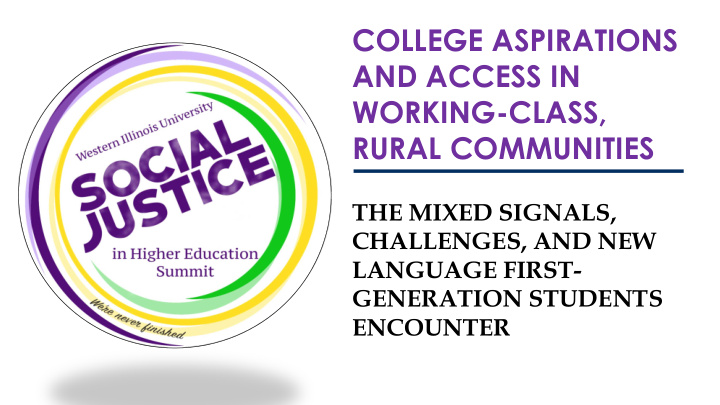



COLLEGE ASPIRATIONS AND ACCESS IN WORKING-CLASS, RURAL COMMUNITIES THE MIXED SIGNALS, CHALLENGES, AND NEW LANGUAGE FIRST- GENERATION STUDENTS ENCOUNTER
Sponsors & Hosts The GradCenter: gradcenter.org • Office of Graduate Studies, Western Illinois • University: wiu.edu/graduate_studies College Student Personnel Graduate Program, • Western Illinois University: wiu.edu/csp
Webinar Features Q & A Polling Chat Box
Today’s Moderator Tracy Davis
COLLEGE ASPIRATIONS AND ACCESS IN WORKING-CLASS, RURAL COMMUNITIES THE MIXED SIGNALS, CHALLENGES, AND NEW LANGUAGE FIRST-GENERATION STUDENTS ENCOUNTER Sonja Ardoin
What is Rural? Rural is a “know it when you see it” concept because there are no fixed definitions of rural or rurality. (Flora, Flora, & Gasteyer, 2016; Flora, Flora, Spears, & Sawnson, 1992; Ganss, 2016; Isserman, 2005)
More than one-fourth of 29% college students are from rural areas. (NCES, 2015)
(Hillman & Weichman, 2016, p. 8)
What is Social Class? “A script, map, and guide. It tells us how to talk, how to dress, how to hold ourselves, how to eat, and how to socialize … “ (Lubrano, 2004, p. 5)
At least one-third of college students 33% have poor or working class backgrounds. (NCES, 2017)
Considering Intersections of Identity
Who are First-Generation College Students? (Whitley, Benson & Wesaw, 2018)
More than one-third of college students 36% are first-generation college students. (NCES, 2017)
Pause to Ponder: Questions to this Point?
The Study Element of the Study Details Purpose Explore how rural students obtain and comprehend college knowledge and decode university jargon. Methods Descriptive, Collective Case Study Sites Two, Public Rural High Schools in Southeast with student populations representative of the county demographics Eight Rural High School 10 th Graders Participants Two Rural High School Counselors Data Two Rounds of Interviews Six Months of Observations Numerous Documents Analyzed
We still have a lot of kids who are the first people in their family to graduate high school. Education in a lot of the families is not a priority. In some, it is, but for a lot, it’s not ... a lot of the kids do go straight to work. - High School Counselor #2 They think I should [go to college], but if I don’t want to and I want to go straight to work, they’d be all right with it. –Student “More Trouble Than It’s Worth or a Path to a ‘Better Life’?”: Rural Attitudes About College
It’s too many expectations, especially with the number of high school students that we have. Before consolidation [in 2004] we didn’t have the computer work and paperwork that we have today. Now it’s just more and more and more. –High School Counselor #1 I am a full-time high school counselor but they only have a part- time junior high counselor so Tuesdays and Thursdays, I’m the counselor for the whole student body of 800 kids. –High School Counselor #2 “I Have More to Do Than I Can Possibly Do Well”: Rural Counselors’ Challenges with College Counseling
“I do feel like I need to know more about going to college so I can have more of a chance to get in.” –Student “ All the letters [acronyms] can be confusing .” –Student “I Know What B.S. Means, Just Not in Those Terms”: The Barriers Created By College Knowledge & Jargon
U.S. Higher Ed Institution Jargon Division (Academic Affairs, Student Layers Affairs, Athletics) College and/or Department Student
Recognition of Jargon Terms Student General Jargon Academic Jargon Financial Jargon Degree Jargon TOTAL JARGON Autumn 9 15 7 3 34/54 = 63% Bobby 5 14 7 2 28/54 = 52% Brittany 5 14 6 0 25/54 = 46% Craig 7 9 5 2 23/54 = 43% Emily Anne 6 4 5 1 16/54 = 30% Gibbs 6 7 5 1 19/54 = 35% Joslyn 8 8 6 3 25/54 = 46% Rodger 6 11 5 3 25/54 = 46% TOTALS 52/112 = 46% 82/176 = 47% 46/80 = 58% 15/64 = 23%
Defining Jargon Terms Student General Jargon Academic Jargon Financial Jargon Degree Jargon TOTAL JARGON Autumn 4 3 2 0 9/54 = 17% Bobby 2 3 3 0 8/54 = 15% Brittany 4 13 4 0 21/54 = 39% Craig 4 4 3 0 11/54 = 20% Emily Anne 7 3 2 0 12/54 = 22% Gibbs 4 5 4 0 13/54 = 24% Joslyn 4 7 3 0 14/54 = 26% Rodger 0 5 4 0 9/54 = 17% TOTALS 29/112 = 26% 43/176 = 24% 25/80 = 31% 0/64 = 0%
Pause to Ponder: Questions to this Point?
Implications from the Study (Ardoin, 2018) Policy Implications Assistance for Counselors (e.g., counselors) Furthering Rural University Recruitment Students’ Forms of & Admissions Capital (policy & practice) (e.g., curricular integration; field trips)
Reading Recommendations
Reading Recommendations
Pause to Ponder: Final Questions?
Th Thank Yo You Sonja Adroin Presenter Tracy Davis Moderator Shirley Moore The GradCenter Kellie Larrabee Office of Graduate Studies, Western Illinois University Jill Bisbee College Student Personnel Graduate Program, Western Illinois University
Recommend
More recommend